The right hip hop drum pattern can make or break a track.
Hip-hop drum patterns are the foundation of the genre, driving the rhythm and setting the tone for the rest of the track.
When you’re producing hip-hop beats, you need to create drum patterns that grab listeners’ attention and keep them hooked.
In order to do so, you’ll need to understand the key elements that make up a legendary, professional-sounding beat.
In this article, we’ll delve deep into each of these elements and explore techniques to help you take your drum patterns to the next level.
So, let’s dive in and start building the ultimate hip hop drum pattern.
Table of Contents
- The Best Kick Drum Pattern
- Choosing The Right Kick Drum
- Multiple Kick Drums
- The Traditional Snare Drum Pattern
- Breaking the Rules for Creative Patterns
- Creating A Captivating Hi-Hat Pattern
- Achieving Dynamic and Engaging Hi-Hat Rolls
- Selecting The Right Hi-Hat Samples
- Drum Humanization in Piano Roll: Adding Life and Feel to Your Drum Patterns
- Expanding Your Sonic Palette
- Unconventional Hip-Hop Drum Pattern Methods
- Tuning Your Drum Samples: Enhancing Your Drum Patterns
- Final Thoughts
The Best Kick Drum Pattern

When you’re creating drum patterns for hip hop music, it’s essential to strike the right balance between the kick and bass drum pattern elements.
The bass pattern provides the low-frequency foundation for your beat, supporting the kicks and adding weight to the overall sound.
To achieve this balance, you can start by placing a bass note on the first beat of every measure, even if it’s the same pitch each time.
Once aligned with the kicks, you can then play the two elements against one another without sacrificing the weight of either element.
Since phase cancellation favors the low end, you must make sure the kick and bass don’t cancel one another out, making it extremely counterproductive.
Layering the low-end without care will often result in a loss of low-end, with less than you would have if you only had one.
Choosing The Right Kick Drum

Selecting the perfect kick drum sound for your hip hop drum pattern is crucial, as it sets the tone for your entire track.
The kicks you choose should complement the genre and mood of your music.
For example, if you’re producing a heavy, aggressive track, you might opt for a punchy, distorted kick, while a more laid-back track might call for a softer, rounder kick sound.
When programming your hip hop drum pattern, try switching between multiple kick drums within a single pattern to add variety and depth to your beat.
By alternating between different kick sounds, you can create dynamic contrasts and emphasize specific sections or accents, resulting in a more captivating and engaging drum pattern.
Experiment with different kick textures and tones, and use them strategically to give your beat a unique character and groove.
Multiple Kick Drums

When selecting multiple kick drums for your hip hop drum pattern, it’s important to choose kicks that complement one another.
Look for kicks with distinct tonal qualities that can work together harmoniously to create a cohesive sound.
For example, you might pair a deep, sub-heavy kick with a punchy, mid-range kick to cover a broader frequency spectrum.
Additionally, consider how each kick’s transients and Sustain characteristics will blend together to ensure a balanced and well-defined drum pattern that maintains clarity and impact.
The Traditional Snare Drum Pattern
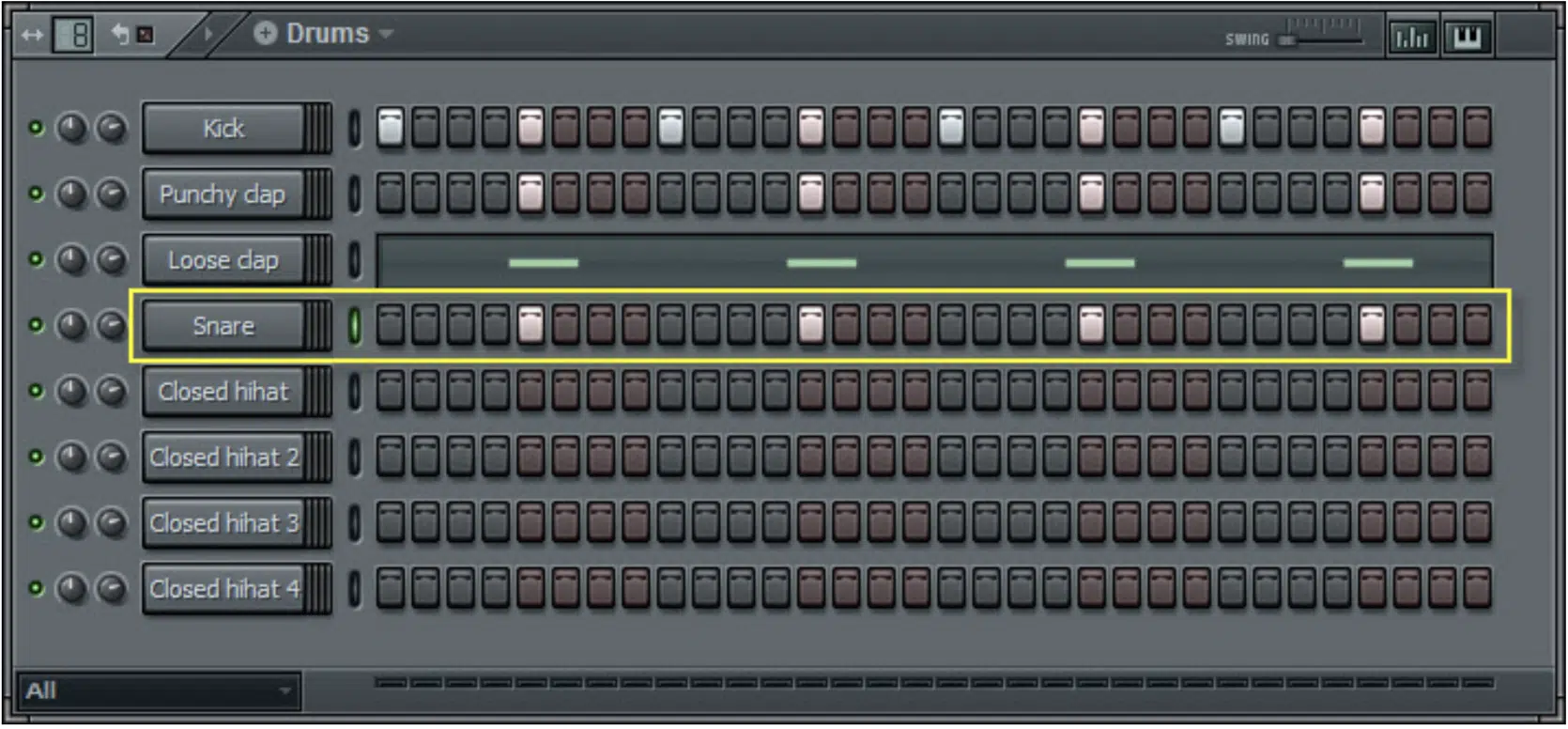
The snare drum is another essential component of a great hip hop drum pattern, acting as the backbone of the beat and defining its groove.
In most hip hop patterns, the snare drum hits on the second and fourth beats of the measure, creating a sense of structure and stability.
However, you can also experiment with placing snare hits off the beat or using syncopation to create a more intricate, engaging snare drum pattern.
Breaking the Rules for Creative Patterns
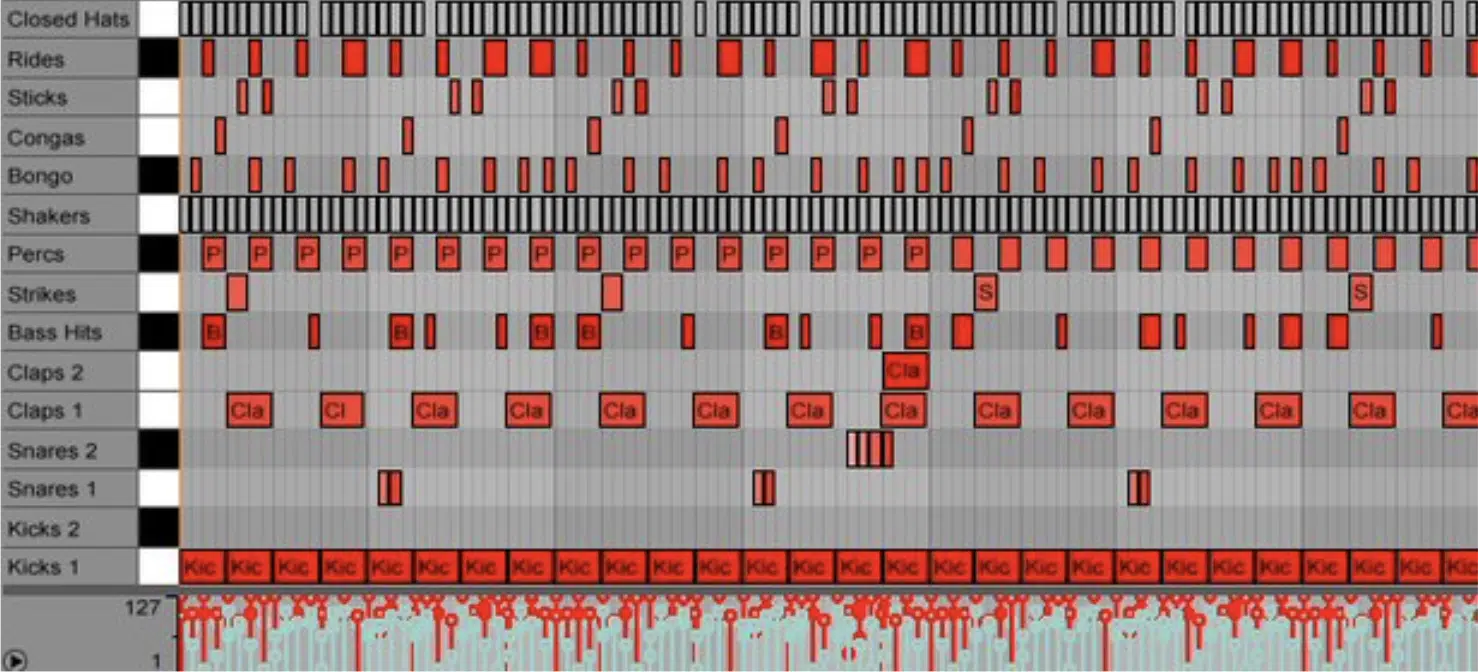
Experiment with programming snares using different time division values to create more intricate and engaging hip hop drum patterns.
For example, you can place the main snare on the standard 1/4 time to establish a solid foundation, while introducing a bounced snare programmed in thirds (such as 1/3 or 1/6) to add a unique rhythmic flair to your beat.
This approach can create interesting polyrhythmic effects and enhance the overall groove, making your drum pattern stand out and keep the listener’s interest.
Creating A Captivating Hi-Hat Pattern
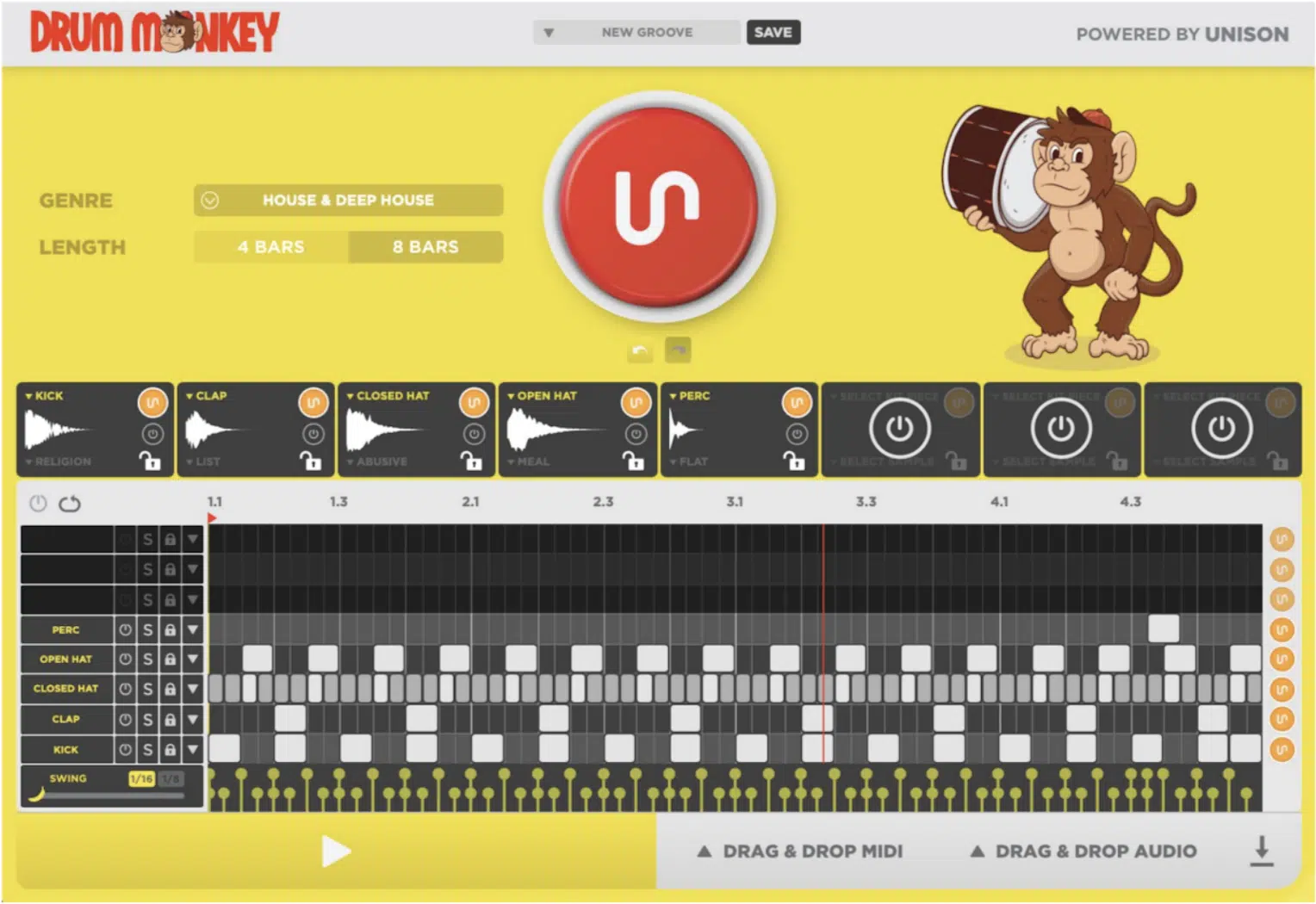
Hi-hats are the spice that adds flavor and character to your hip hop drum patterns.
They help to establish the rhythmic structure of your beat, providing a steady pulse that keeps everything moving forward.
Hi-hats also add a sense of high-frequency energy to your drum pattern, helping to create contrast with the low-end punch of the kick and bass.
To create captivating hi-hat rolls in your hip hop drum patterns, experiment with a range of different time division values.
Achieving Dynamic and Engaging Hi-Hat Rolls
- Begin by programming a basic hi-hat pattern, such as eighth or sixteenth notes, to establish a consistent rhythm.
- Identify the moments within your drum pattern where you’d like to insert hi-hat rolls. These could be transitions between different sections or accents that follow a snare or kick hit.
- In the piano roll, select the hi-hat notes where you want the roll to occur. Change the time division values of the selected notes to create the roll. For instance, switch from sixteenth notes to thirty-second or sixty-fourth notes for a rapid roll effect.
- Vary the time division values within a single roll to create interesting rhythmic patterns. For example, start a roll with thirty-second notes and gradually transition to sixty-fourth notes, or vice versa.
- To add more depth and realism to your hi-hat rolls, adjust the velocities of the individual notes. Lower velocities at the beginning and end of the roll, while increasing velocity in the middle, can create a natural crescendo and decrescendo effect.
- Don’t be afraid to experiment with unconventional time division values, such as triplets or quintuplets, to create unique and attention-grabbing hi-hat rolls that stand out.
Selecting The Right Hi-Hat Samples
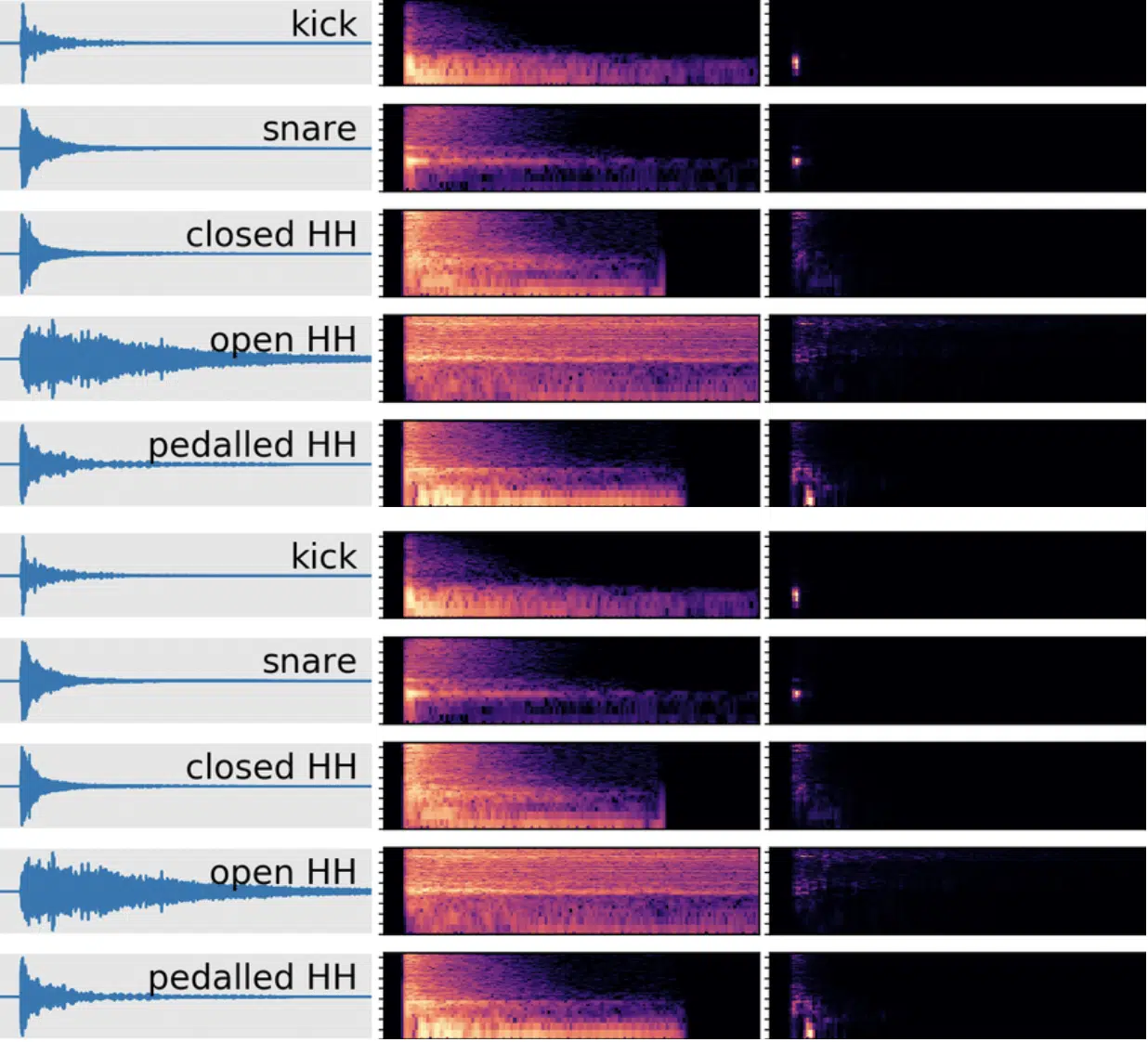
When choosing hi-hat samples for your hip hop drum pattern, it’s important to consider how they will fit with the overall vibe of your track.
A bright, crisp hi-hat might be perfect for an upbeat, energetic track, while a darker, more muted hi-hat could work better for a moody, atmospheric beat.
Experiment with different hi-hat sounds to find the perfect match for your track.
-
Layering Hi-Hat Samples

Just like with Snare drums, layering hi-hat samples can help you create a unique and interesting sound without the phase cancellation issues that arise when layering kicks.
By combining different hi-hat sounds, you can emphasize specific frequency ranges and create a more dynamic, textured pattern.
Try layering a top-end heavy bright, crisp hi-hat with a darker, more muted hi-hat that primarily resides in the lower spectrum (occupying the mids) to create a full-bodied sound that adds depth to your hip-hop drum pattern.
-
Adjusting Hi-Hat Velocities & Pitch
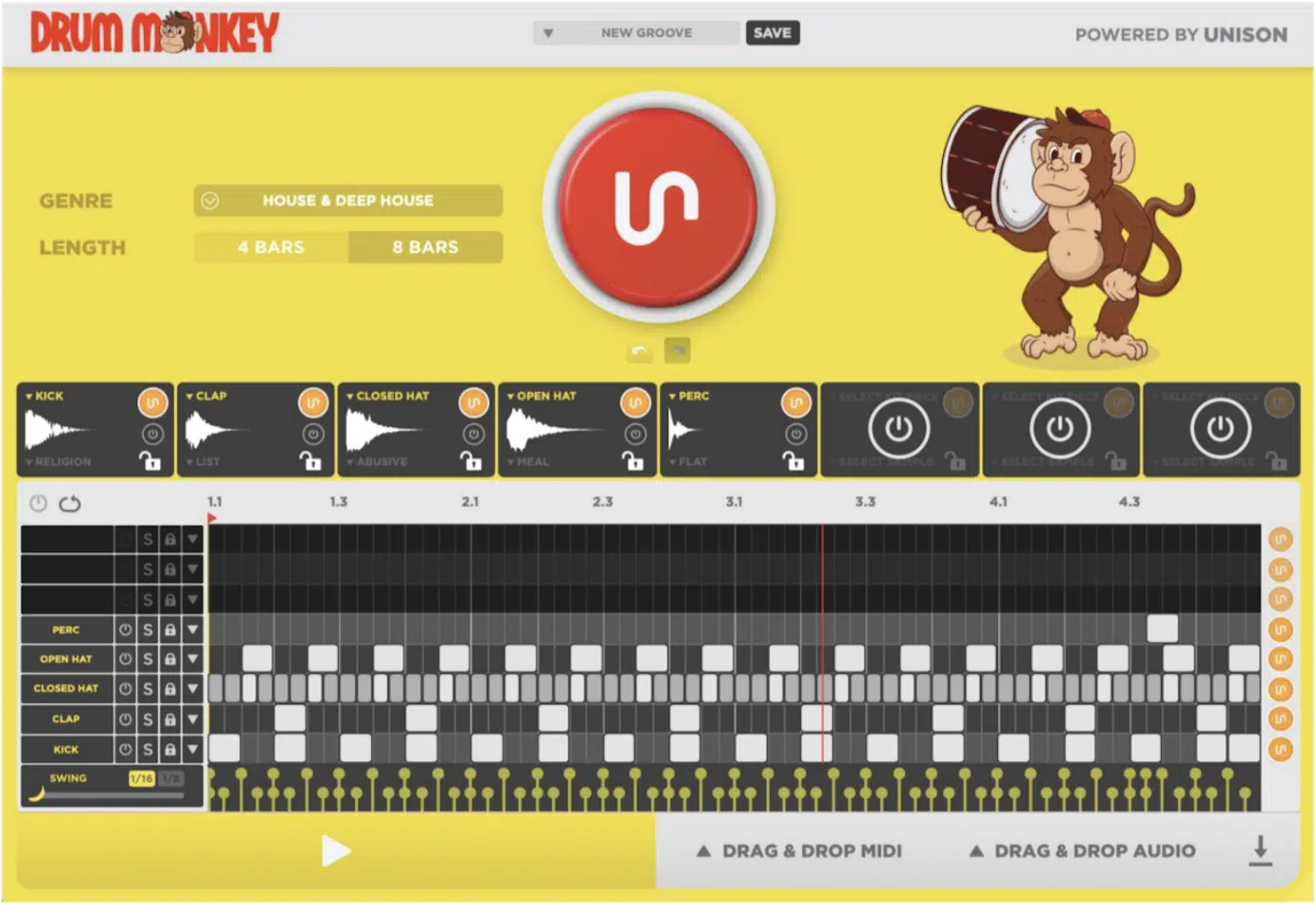
Adjusting the velocities of your hi-hat hits can add a sense of realism and dynamics to your hip hop drum pattern.
Drum Monkey (above) allows you to easily adjust the velocity, along with all the other vital parameters, like Timing and Swing, in order to create the epitome of raw drum patterns.
By varying the velocity of individual hi-hat hits, you can create a more organic, human feel to your pattern.
When you’re learning how to make a beat, experiment with different velocity levels to find the perfect balance that adds interest and intrigue.
Don’t forget to manipulate the pitch of your rolls or those in succession, such as a quick rise in pitch for the triplet roll that’s programmed before the turnaround.
In these instances, it’s usually best to not randomize but rather draw in a ramp (up/down) as shown below.
To take it one step further, impart some evolving randomization by automating these values as well.
Sometimes inside the piano roll, you’ll want to either add or omit certain patterns.
However, once you delete a note it’s gone forever.
Instead, find the Ghost Notes function inside of your DAW in order to save it for later (if desired).
Drum Humanization in Piano Roll: Adding Life and Feel to Your Drum Patterns
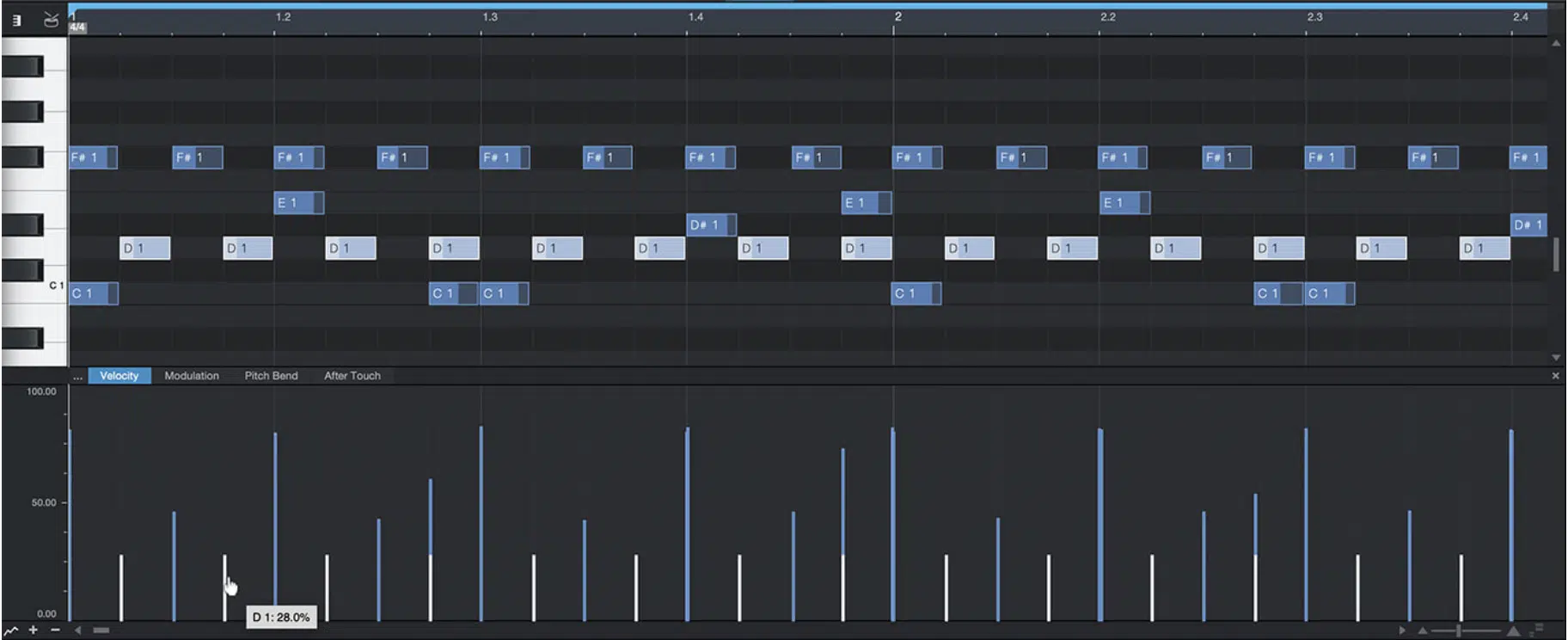
One of the keys to creating captivating music and engaging hip hop drum patterns is to infuse a sense of life and realism into your beats.
Drum humanization techniques, such as adjusting the volume and pitch of each hit, as well as avoiding excessive quantization, can help achieve a more natural and dynamic sound.
-
Volume Adjustments
To add life to your drum pattern, modify the volume (or velocity) of each hit in the piano roll.
Varying the volume of individual hits can create a more dynamic and expressive sound that closely resembles a live performance.
-
Pitch Modulation
Slightly altering the pitch of your drum samples can add a sense of depth and character to your hip hop drum pattern.
Experiment with small pitch adjustments to create a more organic and authentic sound.
-
Timing Variations
Avoiding excessive quantization is crucial in hip hop, especially for drum humanization.
Instead of snapping each drum hit perfectly to the grid, allow for slight timing variations to mimic the natural fluctuations of a live drummer.
The Benefits of Controlled Quantization

Drum Monkey’s Swing function
While quantization can help tighten up your drum pattern, over-quantizing can strip away the natural groove and feel of your beat.
Striking a balance between quantization and humanization ensures that your drum pattern retains its unique character and groove.
Controlled quantization allows for more creative freedom and expression.
It enables you to experiment with different rhythmic patterns and nuances that might not be achievable with strict quantization.
By avoiding excessive quantization, you can craft a more distinctive and memorable drum kit pattern that stands out from the crowd and resonates with your audience.
Expanding Your Sonic Palette
In addition to traditional drum sounds like kicks, snares, and hi-hats, consider incorporating unconventional percussion sounds into your drum patterns.
This can include:
- Found sounds
- Field recordings
- Unconventional instruments like steel drums or tabla
By expanding your sonic palette, you can create a unique and memorable drum pattern that stands out from the competition.
When using unconventional percussion sounds in your hip-hop drum pattern, it’s essential to blend these sounds seamlessly with the more traditional elements of your beat.
This could involve adjusting the pitch, volume, or pan of your unconventional sounds, or layering them with more familiar drum sounds to create a cohesive, unified pattern.
Sure, a foley sample one-shot of banging on a tin garbage bin typically won’t be ideal as a replacement for the snare.
However, if you layer the two, you’ll have a whole new beat on your hands.
Unconventional Hip-Hop Drum Pattern Methods
Now that we’ve covered the basics, let’s explore some unconventional and modern techniques for creating fire hip-hop drum patterns.
-
Polyrhythms
Incorporate polyrhythms into your drum patterns to create complex, layered beats that stand out from the crowd.
Polyrhythms involve multiple rhythms played simultaneously, with different time signatures or subdivisions, resulting in a rich, textured sound.
-
Snare Flams
To add thickness and depth to your snare drum hits, try programming snare flams in your piano roll.
Flams involve a rapid succession of two snare hits, with one slightly offset from the other.
This creates a fuller, more powerful snare sound that can add character to your drum pattern.
-
Hi-Hat Rolls
Experiment with programming hi-hat rolls using a range of different time division values.
This includes eighths, sixteenths, and 1/32, to create intricate, rapid-fire hi-hat patterns that add energy and excitement to your beats.
-
Open Hi-Hats

Try placing open hi-hats on the off-beats or at the end of a measure to create a sense of anticipation and excitement.
-
Triplets
Introduce triplets into your hi-hat programming to create unique rhythmic patterns that break away from the standard straight grid of eighth or sixteenth notes.
Triplets provide a syncopated, rolling feel that can enhance the overall groove of your beat.
Tuning Your Drum Samples: Enhancing Your Drum Patterns
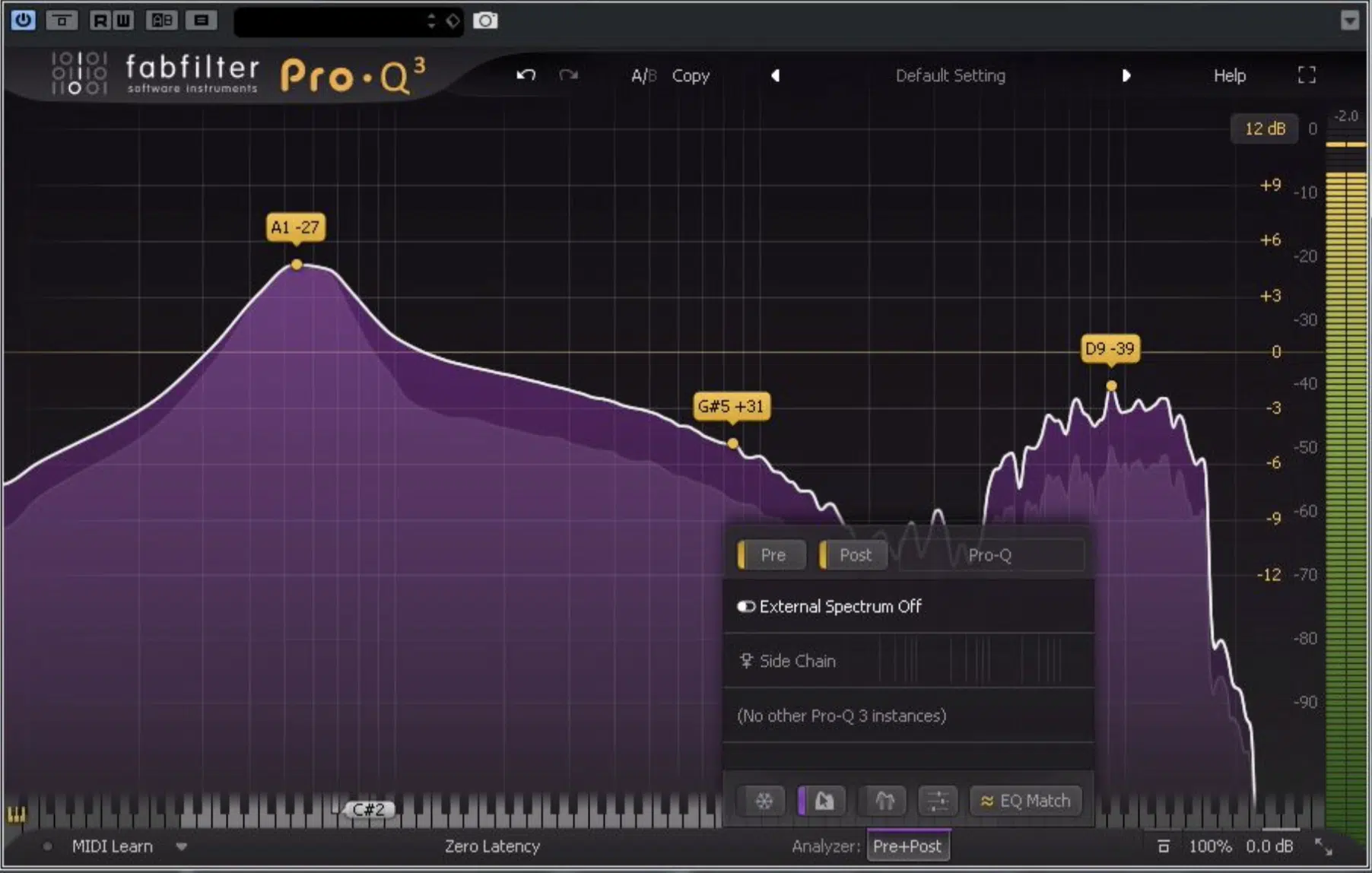
A well-tuned drum sample can make a significant impact on your overall hip hop drum pattern.
By tuning your drum samples, you can achieve a more cohesive and harmonically pleasing sound that complements the other elements in your beat.
The Importance of Drum Tuning
- Harmonic Cohesion 一 Tuning your drum samples to match the key of your beat ensures that all elements work together harmoniously, resulting in a more professional and polished sound.
- Improved Mix Clarity 一 Properly tuned drums can help create a cleaner and more balanced mix, as each drum sound occupies its own frequency space without clashing with other elements.
- Enhanced Groove 一 A well-tuned drum pattern can improve the overall groove and feel of your beat, making it more engaging and enjoyable for the listener.
Tuning Techniques for Various Drum Samples
Each unique element requires its very own process, so knowing the unique process for each is crucial when creating the perfect hip hop drum pattern.
-
Kick Drums
Focus on tuning the fundamental frequency of the kick drum to match the root note or key of your beat.
Use a spectrum analyzer or tuner plugin to identify the fundamental frequency and adjust the pitch accordingly.
-
Snares
For snares, it’s essential to tune the dominant frequency or the “body” of the snare sound to complement the key of your beat.
You can also tune the snare’s overtones or harmonics to further enhance the overall sound.
-
Toms and Percussion
When tuning toms and other percussion elements, consider the role they play in your drum pattern.
Tune them to specific notes within the key of your beat to create a melodic and harmonically pleasing effect.
-
Hi-hats & Cymbals
While hi-hats and cymbals typically don’t require precise tuning, it can be beneficial to adjust their pitch slightly to create a more cohesive sound.
Experiment with tuning them up or down to find the sweet spot that complements your beat.
PRO TIP: Remember to save multiple versions of your pattern.
If you’re unsure about your tuning choices, save multiple versions of your drum pattern with different tuning settings.
This allows you to compare and choose the best option for your beat.
Final Thoughts
In conclusion, mastering the ultimate hip hop drum pattern involves understanding the roles of each drum element, experimenting with unconventional techniques, and selecting the right drum samples.
By carefully crafting your kick, snare, hi-hat, and percussion patterns, and being open to experimentation, you don’t need lessons.
For perfect drum grooves, go download the FREE Unison Essential MIDI Drum Kits.
It includes 5 insanely mind-blowing MIDI drum kits.
You can learn so much about the hip hop drum pattern process, and experiment in endless ways with the help of this free pack.
Whether it’s your third beat or 300th beat, you’ll be able to create a captivating and memorable hip hop drum pattern that sets your track apart from all the rest.
Until next time…







Leave a Reply
You must belogged in to post a comment.